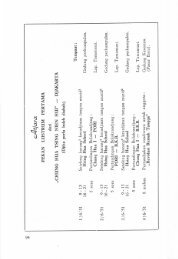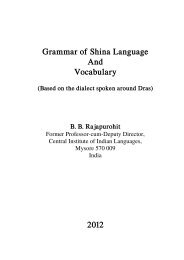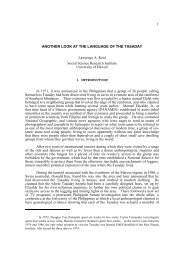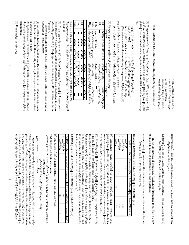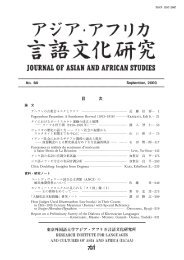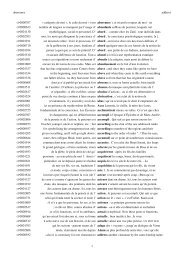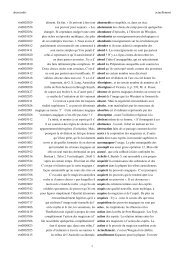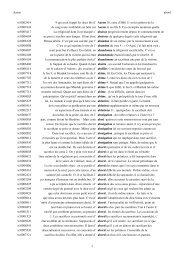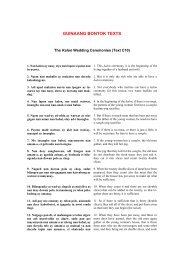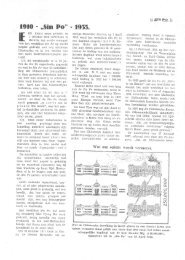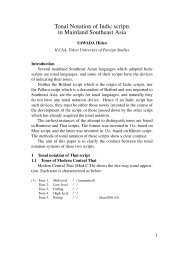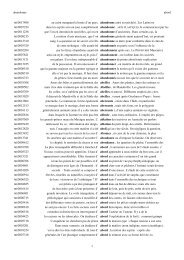PËa-prefixation on verbs and auxiliaries in Lhaovo (Maru) Language ...
PËa-prefixation on verbs and auxiliaries in Lhaovo (Maru) Language ...
PËa-prefixation on verbs and auxiliaries in Lhaovo (Maru) Language ...
You also want an ePaper? Increase the reach of your titles
YUMPU automatically turns print PDFs into web optimized ePapers that Google loves.
pyuF-rĕ-reL pePF-tsoL-TA-cøH-TA-loF-vaH-TA<br />
man-ACC-also beat-eat-&-reach-&-come H -REALIZATION-RLS<br />
‘(The tiger) even kills <strong>and</strong> eats up men.’<br />
<br />
Păy-muNL<br />
it-CONSECUTIVE<br />
Nă-nāūNH-HaF<br />
I-PLR-TOP<br />
myiHthoNF-loNH<br />
even<strong>in</strong>g-time<br />
sakHkeNF-phyoL-meNF<br />
tree-top-LOC<br />
kātH-TA-tōL-TA-TA-raH<br />
make-&-put-RLS-ATTR-RA<br />
kyeNH-meNF-tsaL<br />
rest<strong>in</strong>g place-LOC-<strong>on</strong>ly<br />
Pă-lāūNH * 15 -TA-phoNF-TA-yapF-TA<br />
PRF-always-&-run-&-sleep-RLS<br />
‘So it is that we always run up to the rest<strong>in</strong>g-place <strong>and</strong> sleep <strong>in</strong> the even<strong>in</strong>g.’<br />
• That the first <strong>and</strong> the last sentences of the paragraph are Pă-V sentences shows that the speaker expla<strong>in</strong>s the<br />
sitati<strong>on</strong> patiently.<br />
• If these sentences were not Pă-V sentences nor Pă-AUX sentences, the nuance of explanati<strong>on</strong> would not be<br />
so clear.<br />
(24) yoNL-pamF-HaF myiHthoNF-loNH sakHkeNF-phyoL-meNF kātH-TA-tōL-TA-TA-raH<br />
he-PLR-TOP<br />
kyeNH-meNF-tsaL lāūNH-TA-phoNF-TA-yapF-TA-TA<br />
always-&-run-&-sleep-RLS-ATTR<br />
Pă-kōH-TA .<br />
PRF-PLURAL-RLS<br />
‘It is that they always run up to the rest<strong>in</strong>g-place <strong>and</strong> sleep <strong>in</strong> the even<strong>in</strong>g.’<br />
3.3 Compar<strong>in</strong>g Pă-AUX sentences with Japanese noda sentences<br />
<strong>Lhaovo</strong> Pă-AUX sentence -RLS/NEG-ATTR Pă-AUX -RLS<br />
its ‘truly attributive’ versi<strong>on</strong> -RLS/NEG-ATTR ruF ‘th<strong>in</strong>g’ NatF ‘COPULA’-RLS<br />
Japanese noda sentence -PRES/PAST(ATTR) * 16 no ‘NOMINALIZER’ da ‘COPULA’ -PRES<br />
3.3.1 Core <strong>and</strong> derivative functi<strong>on</strong>s of noda (Ishiguro2003)<br />
1. Core functi<strong>on</strong>: to <strong>in</strong>dicate that <strong>in</strong>sufficient recogniti<strong>on</strong> (of situati<strong>on</strong>) preexist<strong>in</strong>g <strong>in</strong> either the speaker or the<br />
addressee has now become sufficient (underl<strong>in</strong>e by SH)<br />
2. Derivative functi<strong>on</strong>s (i.e. functi<strong>on</strong>s derived from Core functi<strong>on</strong>):<br />
• suppleti<strong>on</strong>: to <strong>in</strong>dicate that the deficiency of the speaker’s/addressee’s recogniti<strong>on</strong> is filled up<br />
• correcti<strong>on</strong>: to <strong>in</strong>dicate that the speaker’s/addressee’s err<strong>on</strong>eous c<strong>on</strong>cepti<strong>on</strong> is corrected<br />
• shar<strong>in</strong>g: to <strong>in</strong>dicate that the recogniti<strong>on</strong> orig<strong>in</strong>ally possessed <strong>on</strong>ly by either the speaker or by the<br />
addressee is shared by both<br />
• presuppositi<strong>on</strong>: to <strong>in</strong>dicate that the sentence is set as the presuppositi<strong>on</strong> of the follow<strong>in</strong>g sentences<br />
*13 We shall call <strong>verbs</strong> which follow <strong>and</strong> modify the ma<strong>in</strong> verb ‘modifier <strong>verbs</strong>’. thoNH c<strong>on</strong>veys the mean<strong>in</strong>g ‘... up’ as a modifier verb.<br />
*14 loH <strong>in</strong>dicate the completi<strong>on</strong> of a change as a modifier verb. Incidentally, H <strong>in</strong> gloss means that the goal of deictic movement is home<br />
positi<strong>on</strong> (<strong>in</strong> its extended sense) for its theme of movement. (Sawada2003)<br />
*15 We shall call <strong>verbs</strong> which precede <strong>and</strong> modify the ma<strong>in</strong> verb ‘pre-modifier <strong>verbs</strong>’. Though lāūNH ‘always’ does not functi<strong>on</strong> as a ma<strong>in</strong><br />
verb, we certify it as a member of verb class, because it can take prefix mă- <strong>and</strong> Pă-.<br />
*16 Except copula da, Japanese tense end<strong>in</strong>gs also functi<strong>on</strong> as attributive end<strong>in</strong>gs.<br />
7



